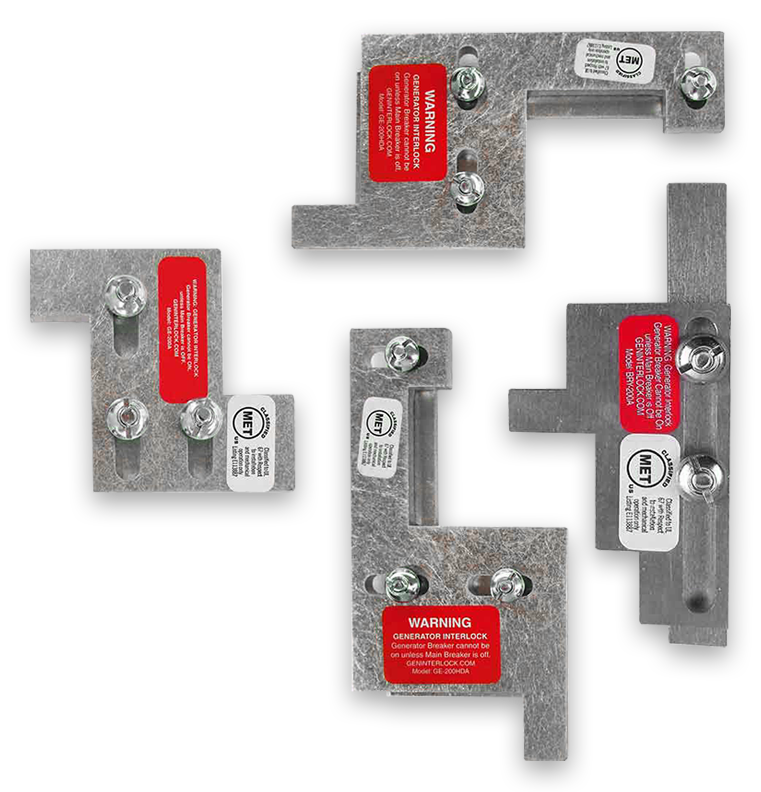What is an Interlock Kit?
Generator interlock kits are devices designed to safely power a home through a portable generator during a power outage by connecting the generator to the existing electrical system. It is an affordable alternative to a transfer switch.
An interlock kit prevents the main breaker on your electrical control panel from being turned on at the same time as your generator breaker. When you are using your generator, it also prevents power from being backfed into the power lines. This is important because it can injure whoever is working to repair your mainline power.
How Does It Work?
When your utility power goes out, using your generator to power your panel is easy. Turn off all the breakers in the panel including the main breaker, slide the interlock bar to lock the main breaker in the off position, and turn on the generator backfeed breaker. Start your generator, plug your the male end of your generator cord to the generator panel, plug the female end of your generator cord into the inlet installed by your electrician, and turn on the generator breaker.
The panel is now accepting power from the generator into the panel. The main breaker is off, which keeps the external mains separate. At this point, you will be able to turn on any individual breakers you need. The only one that must stay off is the main breaker.
Once power is restored, all you have to do it turn off all of the breakers and slide the interlock bar to lock the generator breaker in the off position. This will expose the main breaker once more. After turning the main breaker back on, you can turn on each individual breaker once more. Be sure to unplug the generator power cord and store the generator once you’re done using it.
Shop Now
Generator Interlock Kits


The Benefits of Using an Interlock Kit
- Mounts to the existing panel cover.
- Easy and fast to install. Commonly less than 1 hour with a qualified electrician.
- Laser cut to ensure the accuracy of our designs.
- Meets National Electrical Code 702.4 regarding installation and operation of optional standby systems.
- Convenient. Interlock kits do not require a separate panel to operate. Instead, they are installed directly onto your home breaker panel.
- Affordable. These kits are very cost-effective, typically ranging from $50 to $150 per kit. Conversely, a transfer switch can cost anywhere from $500 to $1,500.
- Flexible. You will be able to choose which electrical circuits are powered by the generator. This offers much more freedom than a pre-wired transfer switch.


Electrical Codes for Generator Interlock Kits
Although there isn't a defined industry standard for mechanical interlocks, testing laboratories conduct evaluations to verify that the installed interlock kit effectively prevents multiple power sources from operating simultaneously. Additionally, they ensure that the interlock kit, considered an accessory to the panel, does not compromise the UL listing (UL 67) of the panel to which it is affixed.
The Interlock is more stringent and aligned with the NEC Section 702 (National Electrical Code) for safe use.
US NEC 702 Optional Standby Systems
This code requires that the standby or backup system can support the selected loads. These loads are selected by the amount of power that needs to be maintained by the backup generator. Standby electrical systems have the option to include legal systems, optional standby systems, and backup systems. Although both legal and optional standby systems are included in the NEC Chapter 7 Articles 701 and 702, backup systems are not.
To be up to code, your generator interlock kit must allow only one of the breakers to be in the “ON” position at one time. This meets the requirements of Article 702 of the National Electrical Code ANSI/NFPA 70.
Generator interlock / Transfer Switch Caution Labels NEC Article 702.7 Caution label: This label is required for all standby or portable generators as per the National Electric Code Article 702.7. You will receive a total of 4 labels; one is for the meter pan on the outside of the home, and the rest are for where the interlock kit is installed.
US NEC 408.36 Overcurrent Protection of Panelboards
Specifically, electrical panelboards must be protected from over-currents by a single device. This must either be located ahead of the panelboard, within the panel board, or at any point on the supply side of the panelboard.
One specific section is good to note: “Each lighting and appliance branch-circuit panelboard shall be individually protected on the supply side by not more than two main circuit breakers or two sets of fuses having a combined rating not greater than that of the panelboard.” – US NEC 408.36
As long as you install the breaker retaining strap, you will appropriately meet the requirements of Article 408.36.

Power Your Whole Home

























































